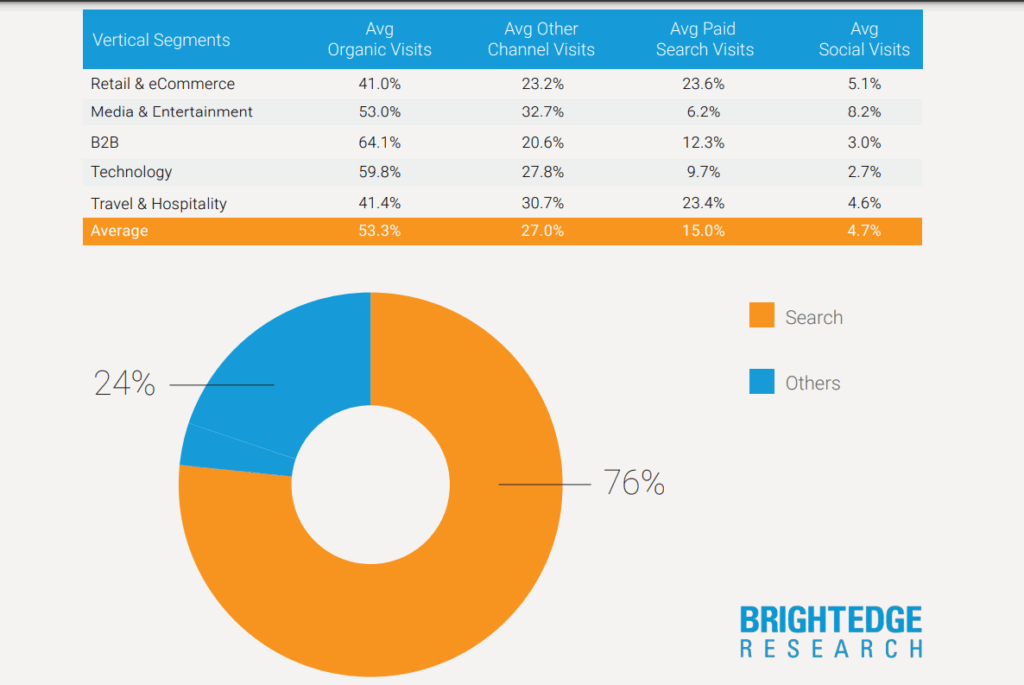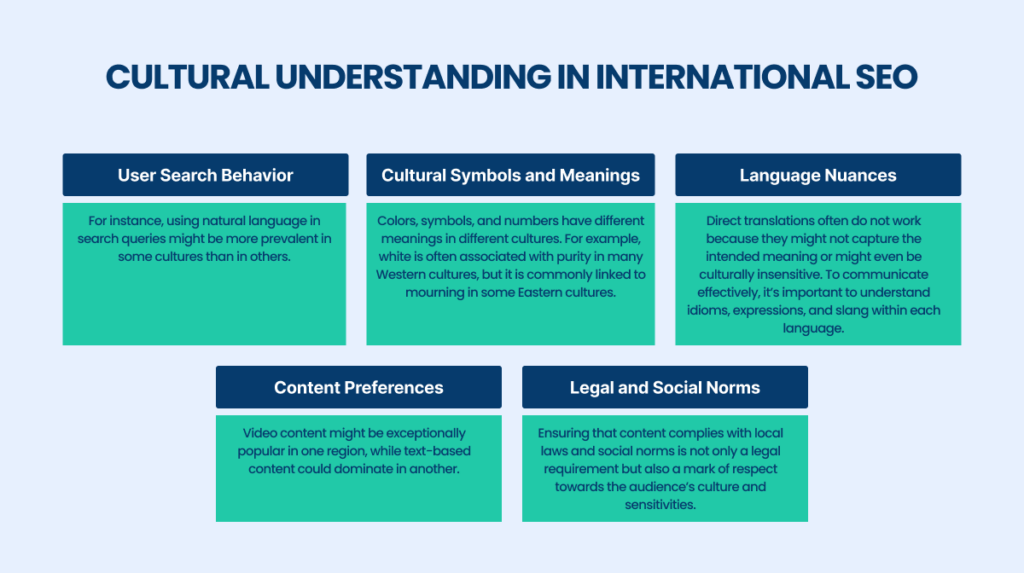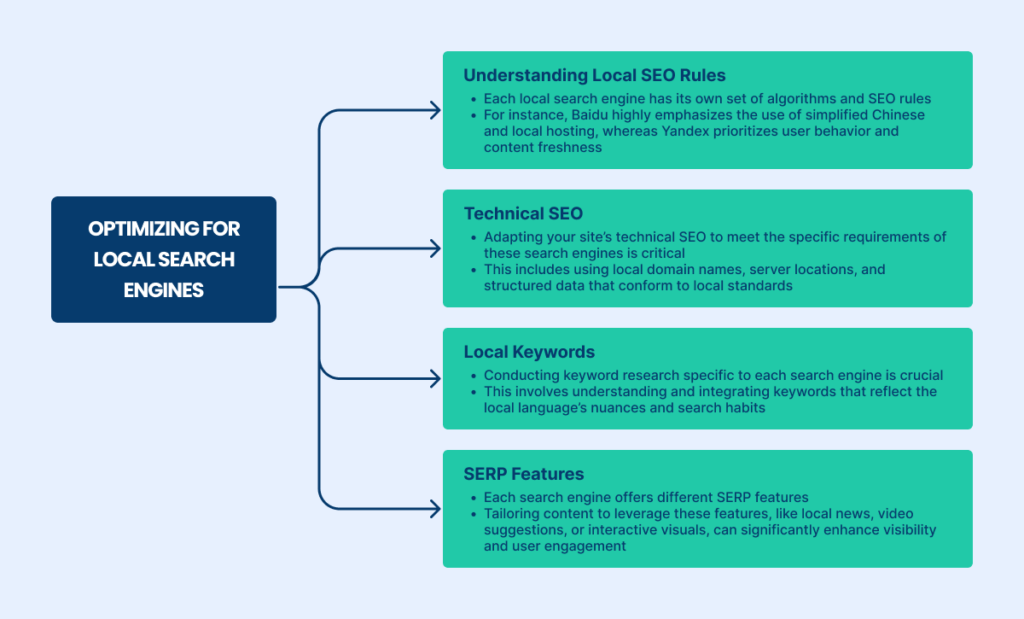Have you ever dreamt of seeing your business thrive on a global scale?
International SEO is the key to unlocking your website’s potential and helping it to the top of search engines across different countries and languages.
In today’s globally connected world, the potential to reach audiences across borders is enormous, but so are the challenges. A quality SEO agency can handle these carefully.
Partnering with an experienced SEO agency or expert can help you navigate these complexities, from localization to audience targeting.
Whether you’re a small enterprise taking your first steps abroad or a multinational corporation refining your existing global strategy, mastering international SEO is crucial for capturing the attention and loyalty of global consumers.

Source: Brightedge
According to Forbes, Google has over 8.5 billion searches per day worldwide. If your website isn’t fine-tuned for organic search results on Google, you’re overlooking a significant opportunity.
Developing an SEO strategy immediately is crucial to capitalizing on this potential.
The blog post will discuss the key strategies to expand the reach for moving to International SEO.
Let’s dive in.
What is International SEO?
It refers to optimizing your website so that search engines can conveniently identify which countries you want to target and which languages you use for business.
Source: Google Search by country, Statista
A solid international SEO strategy helps you:
- Reach audiences in multiple regions and languages.
- Rank higher in local search results for each market.
- Provide a seamless experience for users, no matter their country or language settings.
This branch of SEO is crucial for companies aiming to reach audiences beyond their local geography. It involves multiple strategies, from multi-regional and multilingual optimizations to understanding and integrating various cultural nuances into your content.
The primary objectives of international SEO are to increase your site’s visibility in international markets and drive traffic from diverse geographic regions. This involves translating content into various languages and optimizing that content for specific regional search behaviors and preferences.
Effective international SEO helps businesses tap into new markets, expand their customer base, and grow internationally by making their products and services accessible and relevant to a global audience.
Differences Between International and Local SEO
The key distinctions between international SEO and local SEO lie in the scope and strategies of optimization.
While local SEO focuses on optimizing a site to attract traffic from a specific locality or region, international SEO targets multiple regions across different countries. This difference in scope requires unique strategies and an understanding of various international markets.
- Scope and Scale: International SEO covers a broader scale, dealing with multiple countries, languages, and cultures. Local SEO focuses on specific cities or regions within a single country.
The former requires a more extensive SEO strategy, often incorporating advanced SEO and programmatic SEO techniques to handle complex optimizations across different languages and search engine behaviors.
- Cultural and Linguistic Considerations: Unlike local SEO, which primarily deals with one language and cultural context, international SEO must navigate multiple languages and cultural nuances.
This includes translating content accurately and localizing the content to fit cultural preferences and taboos, which can significantly impact user engagement and SEO effectiveness.
- Technical Implementations: International SEO often involves complex site structures to manage multiple language versions of a site. Techniques like hreflang tags, which help search engines understand the language and regional targeting of pages, are crucial.
Technical SEO aspects are less prominent in local SEO, which typically focuses on geo-targeting and local citations.
- Search Engine Variations: While Google might be the primary focus of local SEO efforts, international SEO must account for other search engines that are popular in different countries, such as Baidu in China, Yandex in Russia, or Naver in South Korea.
Understanding how these search engines work and optimizing for them is a critical component of a successful international SEO strategy.
Analyzing Your Global Audience
In the dynamic world of global digital marketing, understanding and strategically targeting your international audience is paramount.
This involves a multifaceted approach that consists of identifying potential markets, understanding cultural nuances, and localizing content to engage diverse international audiences effectively.
To build a strong international SEO strategy, you should also:
• Analyze search behavior and popular keywords within each region.
• Adapt your messaging and visuals to align with local preferences.
• Make sure your website architecture supports multiple languages and regions using hreflang tags or subdirectories.
• Optimize for local search engines, not just Google, for example Baidu in China or Yandex in Russia.
This strategic blend of data, culture, and technical optimization helps your brand resonate globally while maintaining local authenticity, which is the essence of successful international SEO.
Identifying Target Countries
Criteria for Selecting Target Markets
The first step in expanding your international reach is to compare SEO vs. SEM and decide which countries to target. Regarding SEO, it is essential to think about which countries to target. Several strategic factors should drive this decision:
- Market Size and Potential: Evaluate the potential audience for your International SEO services or products by examining the country’s population size and internet usage statistics.
- Economic Factors: Consider consumers’ economic stability and spending power in the target market. Higher economic stability can translate to greater purchasing power and a more significant potential return on investment.
- Competitive Landscape: Analyze the current market competition. A market with fewer competitors can be attractive, but a competitive market might also indicate a high demand for your products or international SEO services.
- Legal and Regulatory Environment: Understand digital content’s legal constraints and regulations in your target markets. Some countries have stringent rules that might affect your SEO strategies and online content distribution.
- Cultural Fit: Evaluate how well your brand fits into the cultural context of the representative market. This includes considering consumer behavior, preferences, and local trends that might impact your brand’s acceptance and success.
- Search Engine Market Share: While Google holds a significant share of the global search engine market, countries like China and Russia prefer Baidu and Yandex, respectively. Tailoring your SEO strategy to the dominant search engines in these regions is crucial.
By using AI in SEO, companies can process vast amounts of data more efficiently to identify the most lucrative markets. AI-driven analytics help pinpoint future SEO trends and preferences, making the selection process more data-driven and less susceptible to biases.
Cultural Considerations in SEO
The understanding of cultural considerations is crucial in international SEO. Each market has its own cultural context, which strongly affects how marketing content is perceived and how well it engages the audience.
To incorporate cultural considerations effectively:
• Research local customs, traditions, and taboos that may influence content perception.
• Adapt messaging and visuals to fit cultural expectations and preferences.
• Tailor marketing tactics for each region to maximize engagement.
• Ensure content resonates with the target audience at every stage, from creation to promotion.

Language and Localization Strategies
Importance of Accurate Translations and Local Nuances
Localization goes beyond mere translation. It involves adapting your website and its content to meet the language and cultural assumptions of the target market. This strategy is crucial for connecting with the audience on a deeper level.
- Translation Accuracy: Employ skilled translators who are native speakers of the target language to guarantee the accuracy and appropriateness of the language used on your website.
- Local Terminology and Keywords: Conduct keyword research specific to each locale to understand what terms and phrases are most likely used by your target audience. This might include variations in dialects or colloquial language that are more likely to be used in search queries.
- Cultural Customization: Customize the website experience to align with local customs and practices. This could involve changing the layout, modifying graphical elements, or adapting the navigation structure to better suit local user behaviors.
- Regulatory Compliance: Each country has its own internet regulations governing how data is collected, stored, and used. Localizing your SEO strategy means ensuring compliance with these laws to avoid penalties.
- Local Trends and Media: Stay updated on local trends and media consumption habits. Integrating popular local media formats and platforms into your strategy can significantly enhance engagement and SEO performance.
Technical SEO for International SEO Services and Markets
The distinction between on-page SEO vs. off-page SEO lies in where the optimization activities occur and how they influence search engine rankings. Technical SEO is the backbone of effective international SEO strategies, addressing websites’ structural and technical needs and targeting multiple geographic locations and languages.
Structuring Your International Website
ccTLDs vs. Subdirectories vs. Subdomains
Choosing the right URL structure is pivotal in international SEO as it helps signal to search generative engines (SGE) and users the geographic targeting of your content. Here are the three most common structures used:
- Country Code Top-Level Domains (ccTLDs): These are top-level domains specific to a country (e.g., .fr for France, .jp for Japan).
Using ccTLDs strongly signals to search engines about a website’s geographic targeting, which can be beneficial for ranking in local search results. However, managing multiple ccTLDs can be costly and requires building domain authority for each from scratch.
- Subdirectories: This approach involves creating separate directories for each country within the same domain (e.g., example.com/fr/ for France). Subdirectories are easier to manage because they inherit the domain authority of the primary domain and are less expensive than maintaining multiple domains.
However, their geographical signaling to search engines is weaker than ccTLDs unless supported by other localization signals.
- Subdomains: Enable to create a separate subdomain for each country (e.g., fr.example.com for France). They are somewhat easier to set up than subdirectories and provide better geographic targeting than a single global domain.
However, like ccTLDs, subdomains may need to build authority independently.
The choice among ccTLDs, subdirectories, and subdomains depends on various factors, including budget, existing domain authority, and specific business needs for local presence and control over the website’s content across different regions.
Hreflang Tags and Language Annotations
Implementing hreflang Tags for Language and Regional URLs
Hreflang tags are essential to international SEO, helping search engines understand your content’s language and geographic targeting. These tags inform Google and other search engines which option of a page should be shown to users in a specific language or region.
Properly implementing hreflang tags ensures users see the content in their preferred language, contributing user experience and engagement.
To implement hreflang tags correctly:
- Specify language and country codes: Use ISO 639-1 format for language and ISO 3166-1 Alpha 2 format for countries.
- Apply tags across all regional versions: Each page should contain hreflang tags for every version, including itself.
- Ensure consistency: The hreflang tags must be reciprocal; if page A links to page B, page B must link back to page A.
Tools like Google Search Console can be invaluable in monitoring the performance of your hreflang tags, ensuring that they are recognized correctly by Google and troubleshooting common issues like incorrect language codes or missing return links.
Managing Duplicate Content Across Regions
Strategies to Avoid Penalization for Similar Content in Different Languages
Duplicate content in international SEO can lead to significant issues, including decreased search visibility and potential search engine penalization.
Source: Content Marketing Institute
However, managing content across multiple languages and regions often inherently involves similarities that search engines might mistakenly view as duplicate content.
To manage duplicate content effectively:
- Use hreflang tags: Correctly implemented hreflang tags help search engines understand that similar content in different languages or regions is intended for different audiences, not duplicated.
- Localize content: Beyond mere translation, localizing content to reflect local idioms, cultural references, and context can significantly differentiate content across regions.
- Leverage canonical tags: If the content is duplicated across different regions with minor changes, canonical tags can point search engines to the ‘original’ version of the content.
By combining these strategies with ongoing monitoring using tools like Google Analytics and Google Search Console, businesses can effectively manage their SEO efforts and avoid potential pitfalls in their international SEO endeavors.
Moreover, SERP features, such as featured snippets, knowledge graphs, and local packs, significantly enhance visibility on search engine results pages.
These technical elements, from choosing the right URL structure to handling hreflang tags and managing duplicate content, lay the foundation for successful international SEO that resonates with a global audience.
Content Strategies for International SEO Services
In digital marketing, International SEO is a crucial strategy for businesses striving to extend their reach across global markets. Effective content strategies tailored for different regional markets are essential for engaging diverse audiences and optimizing search engine visibility internationally.
Below, we explore three fundamental aspects of content strategies for International SEO: creating locally relevant content, optimizing for local search engines, and leveraging local social media platforms.
Creating Locally Relevant Content
Tailoring Content to Meet Local Needs and Preferences
Creating content that resembles local audiences is more than mere translation; it involves deep cultural customization to reflect local preferences, behaviors, and nuances. E-E-A-T Google (Experience, Expertise, Authoritativeness, Trustworthiness) is crucial in assessing the quality of web pages and their content, influencing search rankings significantly.
This approach ensures that the content is understandable but also engaging and relevant.
- Market Research: Conducting extensive market research is the first step in understanding what drives and interests your target audience. This involves language targeting and recognizing local consumer behaviors, preferences, and pain points.
- Cultural Adaptation: It’s crucial to adapt your content culturally. This means considering everything from the choice of colors and images to the tone and formality of the language used, as these can vary greatly across cultures.
- Local Trends and Media Consumption: Monitoring local trends and the types of media consumed can guide the creation of appealing and relevant content. For instance, video content might be the preferred format in one country, whereas in-depth articles might resonate more in another.
- Customer Feedback: Integrating local customer feedback into content creation can also help you tailor your messaging to meet the local audience’s needs and increase engagement rates. SEO automation tools can enhance this process by efficiently analyzing customer feedback across different regions and extracting valuable insights.
Effective content localization enhances user experience and boosts content relevance in local search results, adhering to international SEO best practices.
Optimizing for Local Search Engines
Beyond Google: Baidu, Yandex, Naver, and others
While Google might dominate global search engine usage, other local search engines, such as Baidu in China, Yandex in Russia, and Naver in South Korea, play pivotal roles in their respective markets. Optimizing for these search engines can open up significant opportunities in these regions.

Optimizing for these local search engines requires a deep understanding of their specific algorithms and user preferences. It is a critical part of any global SEO strategy.
You shouldn’t neglect Mobile Optimization. Mobile SEO is essential, ensuring a website is optimized for smartphone users and improving usability and rankings in mobile search results.
Engagement Through Local Social Media Platforms
Leveraging Local Social Networks for Engagement and SEO Benefits
Social media platforms vary widely across different regions, and tapping into these networks is essential for amplifying your content’s reach and enhancing local SEO efforts.
- Platform Popularity: Identify which platforms are most popular in your target regions. While Facebook and X are widely used globally, platforms like WeChat in China, VKontakte in Russia, and Line in Japan hold substantial sway in their respective markets.
- Content Customization for Social Media: Tailor your content for each platform based on each platform’s typical content format and user interaction style. For instance, some platforms may favor shorter, more visual posts, while others may engage more deeply with long-form content.
- User Engagement: Engaging with users on these platforms can help boost your brand’s visibility and white-hat SEO. This includes responding to comments, participating in discussions, and using local hashtags.
- Integration with Other SEO Efforts: Ensure your social media strategy is integrated with other SEO efforts. Social media platforms drive traffic to your optimized web pages, boosting overall SEO performance.
Partner with [A] Growth Agency For Mastering International SEO Strategies
The journey to international SEO success is ongoing. By now, you’re armed with the knowledge and strategies to transform your website into a global magnet, attracting customers from every corner of the web.
[A] Growth Agency will implement all the discussed approaches.
We strive to design a Growth Roadmap that encompasses your business vision, strategy and tactics your business needs to grow. Our specialists aim to build lasting partnerships for lasting success.
Moreover, we believe in the power of data to inform and drive every strategy, ensuring our actions are as effective as they are innovative.
If this matches your business ideas, go ahead!

